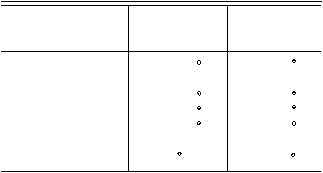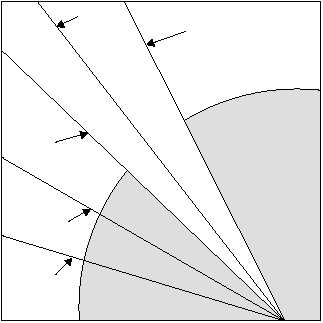indicated by changes of lapse rate with height. (See
table 2-1 and fig. 2-8.)
DRY ADIABATIC LAPSE RATE.—If a parcel
of air is lifted, its pressure is DECREASED, since
pressure decreases with height, and its temperature falls
due to the expansion. If the air is dry and the process is
adiabatic, the rate of temperature fall is 1°C per
100 meters of lift (10°C per Kin), or 5 l/2°F per 1,000
feet of lift. If that parcel descends again to higher
pressure, its temperature then INCREASES at the rate
of 1°C per 100 meters or 5 1/2°F per 1,000 feet. This is
known as the dry adiabatic lapse rate.
MOIST (SATURATION) ADIABATIC LAPSE
RATE.—When a mass of air is lifted, it cools at the dry
adiabatic lapse rate of 5 1/2°F per 1,000 feet as long as
it remains unsaturated (relative humidity below 100
percent). If the original moisture is being carried along
with the mass as it ascends and it cools to its saturation
temperature, the relative humidity reaches 100 percent.
Condensation takes place with further cooling. For
each gram of water condensed, about 597 calories of
heat are liberated. This latent heat of condensation is
absorbed by the air, and the adiabatic cooling rate is
decreased to 20 to 3°F per 1,000 feet instead of 5 1/2°F
per 1,000 feet. The process during the saturated
expansion of the air is called the saturation adiabatic,
the moist adiabatic, or the pseudoadiabatic process.
The pseudoadiabatic process assumes that moisture
falls out of the air as soon as it condenses.
Assume that a saturated parcel of air having a
temperature of 44°F is at 5,000 feet and is forced over a
12,000-foot mountain. Condensation occurs from
5,000 to 12,000 feet so that the parcel cools at the moist
adiabatic rate (3°F per 1,000 ft) and reaches a
temperature of approximately 23°F at the top of the
mountain. Assuming that the condensation in the form
of precipitation has fallen out of the air during the
ascent, the parcel heats at the dry adiabatic rate as it
descends to the other side of the mountain. When it
reaches the 5,000-foot level, the parcel has descended
7,000 feet at a rate of 5 1/2°F per 1,000 feet. This results
in an increase of 38.5°F. Adding the 38.5°F increase to
the original 12,000 feet temperature of 23°F, the parcel
has a new temperature of 61.5°F.
AVERAGE ADIABATIC LAPSE RATE.—The
average lapse rate lies between the dry adiabatic and the
moist adiabatic at about 3.3°F per 1,000 feet.
SUPERADIABATIC
LAPSE
RATE.—The
superadiabatic lapse rate is a decrease in temperature of
more than 5 1/2°F per 1,000 feet and less than 15°F per
1,000 feet.
AUTOCONVECTIVE LAPSE RATE.—The
autoconvective lapse rate is the decrease of more than
15°F per 1,000 feet. This lapse rate is rare and is usually
confined to shallow layers.
2-15
AG5t0201
Lapse rate
Per 1,000
feet
Per 100
meters
Dry adiabatic
Saturation (moist)
adiabatic
Average
Superadiabatic
Autoconvective
5 1/2 F
2-3 F
3.3 F
5 1/2-15 F
More than
15 F
1 C
.55 C
.65 C
1-3.42 C
More than
3.42 C
Table 2-1.—Lapse Rates of Temperature
MOIST
ADIABATIC
AVERAGE
LAPSE
RATE
"DRY"
ADIABATIC
SUPER
ADIABATIC
AUTO
CONVECTIVE
AG5f0208
Figure 2-8.—Adiabatic lapse rates.





